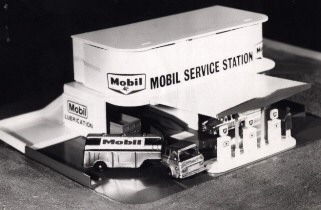Pressure die-casting is a manufacturing process of long standing, used where large quantities of small metal products are required cheaply and repetitively. During the early to middle years of the last century, there was a world wide market explosion for small die-cast cars and vehicles.
Dies of special steel were made and mounted on a pressure die-casting machine. These dies had cavities equal to the product required, and also a separate system of tubes which circulate cold water throughout the dies, controlling the die temperature. The dies could be hydraulically opened or closed with a lever.
The metal used in this type of product was usually a cheap zinc alloy called "Mazac," which has a very critical melting point. When the Mazac was melted, it only needed a slight drop in temperature to solidify. With the dies closed, a second lever was operated and the molten Mazac was pumped into the die cavity under pressure, forming the desired product.
The circulating water cooled the Mazac almost instantly, the dies were clicked open and the product ejected from the dies to a chute leading to a receptable.
The ejector pins leave a small circle where they exert pressure, and these marks can be seen on the die-cast product at strategic places.
The DCMT machines used by The Underwood Engineering Company were "vintage" and manually operated. While one of these machines could reach over 3000 shots a day, our competitors in Japan, China and other countries, had automatic machines that could produce several times that quantity. This last factor was one of the reasons why this type of toy manufacturing has almost ceased in New Zealand
Apart from the first nine dies, which were obtained from Streamlux in Australia, nearly all the subsequent dies were made in Underwood's Toolroom. Records show that a total of over 8 million Midget toys were manufactured at the Fun Ho! Factory in Inglewood between 1965 and 1982.

Official Fun Ho!/Mobil icon